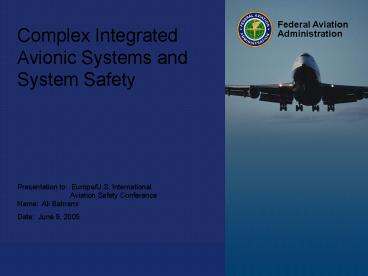Complex Integrated Avionic Systems and System Safety - PowerPoint PPT Presentation
1 / 13
Title:
Complex Integrated Avionic Systems and System Safety
Description:
TSO functionality may be embedded in an integrated avionics suite ('functional TSO' ... Global design and manufacturing of highly integrated avionics functions. ... – PowerPoint PPT presentation
Number of Views:430
Avg rating:3.0/5.0
Title: Complex Integrated Avionic Systems and System Safety
1
Complex Integrated Avionic Systems and System
Safety
Presentation to Europe/U.S. International
Aviation Safety
ConferenceName Ali Bahrami Date June 9, 2005
2
Trends in Avionics Integration and Complexity
2000
1980
1990
- Integration of many avionics functions
- Card-based processors in cabinet racks
3
Trends in Avionics Architectures
- Huge increases in
- Functional integration.
- Software size and complexity.
- Shift in techniques for isolation/independence
- Traditionally, redundant features were completely
isolated now they communicate with each other. - High/low criticality functions traditionally
physically isolated from each other now share
computing and databus resources. - Mix of new and reused (legacy) software.
4
Trends in Avionics TSO
- TSOs
- Traditionally, TSOs were used for simple
equipment (e.g. seat belts) and well-defined
stand-alone functions (e.g. air speed
indicator). Installation issues were minimal. - Now, TSO requirements cover only a small fraction
of the designed functionality. - TSO functionality may be embedded in an
integrated avionics suite (functional TSO). - Vendors need TSOA to ship brain-dead hardware
which doesnt comply with the full TSO
requirements until installed and software is
loaded.
5
Trends in Avionics Engineering and Business
Practices
- Increasing dependence on Commercial Off-the-Shelf
(COTS) hardware and software. Examples - Microprocessors (from PC industry).
- Operating systems (e.g. Windows).
- Graphic processors (from video game industry).
- Changes in manufacturer-vendor relationships and
responsibilities. - Global design and manufacturing of highly
integrated avionics functions. - Shift from airframe manufacturer as
designer/builder to integrator/assembler.
6
Certification Challenges
- Integration and complexity
- Current processes (e.g. DO-178B/ED-12B for
software) were developed with much simpler
architectures in mind. - Experience is showing that there are complex and
often unexpected connections between
traditionally unrelated or independent functions,
especially during failures. - Failures become more difficult to predict and
diagnose. - It becomes less and less feasible to test all
inter-related failure modes. - Fully integrated test facilities become more
challenging and expensive to build and operate.
7
Certification Challenges
- Software
- Software-based isolation and independence is much
more fluid and difficult to assure than relying
on hardware. - Mixing of COTS, reused, and new software all
developed by different processes and to different
standards makes assessing the safety issues
much more difficult, especially in standardized
ways.
8
Certification Challenges
- Functional TSO
- Difficult to separate TSO issues from
installation issues - TSOd function may be part of the software that
resides on a circuit card. - TSO compliance can only be assessed when
installed in the host system. - Even simple issues like part marking become
complicated. - TSO change processes were not developed with
these complex TSO packages in mind. - Engineering and Business practices
- COTS products are not developed to traditional
aviation standards. - Detailed certification data and knowledge often
resides at vendor rather than manufacturer.
9
How the Authorities Have Responded
- The authorities have already taken a number of
actions to support recent IMA trends and specific
projects, including - Development of IMA AC and TSO.
- Development of an Order on software reuse.
- Approval of functional TSOs.
- Numerous DO-178B/ED-12B workarounds.
- Additional relevant guidance is in work.
- However, continued industry support is needed
10
What is Needed to Support the Trend?
- Current software certification methods did not
envision modern IMA architectures, so we need new
methods - That are equally effective in ensuring safety
- While supporting the certification of IMA.
- The current TSO process is not well-suited for
embedded software functions, so we need new
approaches to TSOA - Which allow design and production approval for
traditional TSO functions in IMA architectures - While protecting the level of safety provided by
type certification processes.
11
What is Needed to Support the Trend?
- When manufacturers out-source development and
test - New processes for authorities/manufacturer/vendor
communication are needed. - Testing
- Testing of the IMA pieces will not find
integration problems. - The actual airplane is not an adequate test
environment for many IMA issues. - Full-scale integration test facilities may not be
commercially viable. - Industry needs to help develop new approaches to
integration testing that will find and
characterize IMA problems before certification.
12
Authority-Industry Partnership
- Cooperation is needed more than ever.
- Traditional certification processes were
developed to match past commercial practices - The pace of change is increasing
- Industry will need to lead the effort to develop
new methods of compliance. - New methods cannot just do less they MUST
preserve, and where possible, improve the level
of safety. - Focus on safety-related issues while with IMA, it
is more difficult to separate what is or is not
safety-related.
13
Summary and Future Perspectives
- The authorities support industrys efforts to
advance the technology - Historic cooperation between the authorities and
industry has been essential in developing viable
and effective methods of compliance and safety
assurance. - Cooperation is even more critical as we
collectively support rapid technological advances
while at the same time increase the level of
safety. - Potential broader issue Does the overall safety
assessment process need to be revisited, to
account for the migration of functionality (and
failure conditions) from hardware to software?































